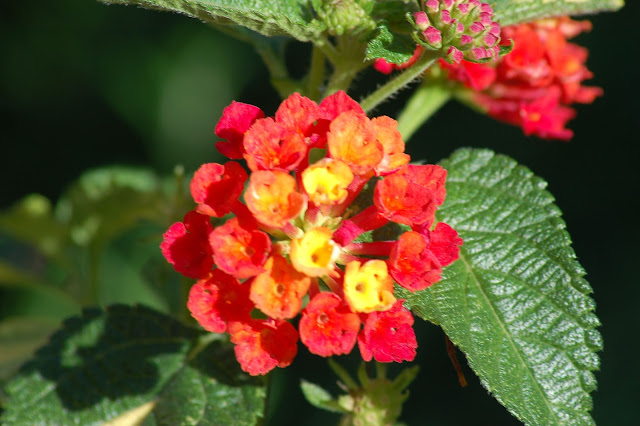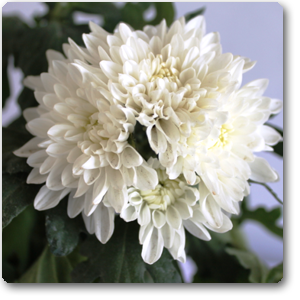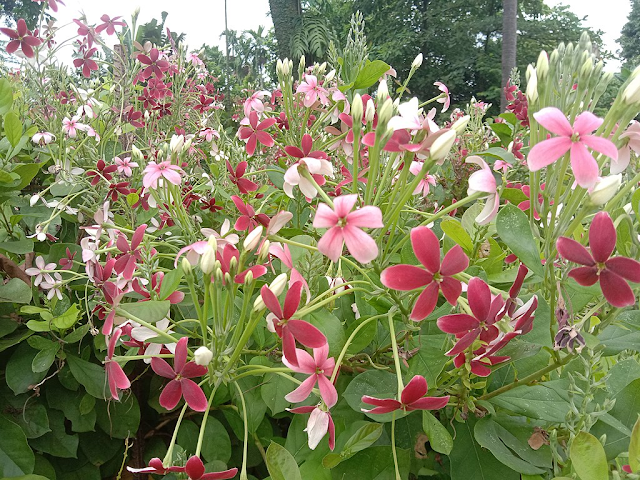Hardy Fuchsia
If your garden needs a burst of color, look no further than hardy fuchsia, which is also referred to as fuchsia magellanica. Keep in mind that the right soil — not too dry, moist or hot — is key for this type of flower.
Dusty Miller
This fluffy silver plant, which is also known as Jacobaea Maritima, would make for an unexpected addition to your garden. Give it full sun and keep it well-drained to stay healthy.
Chrysanthemum / चंद्रमल्लिका
Chrysanthemum Morifolium, Shevanti  |
Chrysanthemum morifolium, Shevanti.
Chrysanthemum. Shevanti, Guldaudi
Red Chrysanthemum. Shevanti, Guldaudi
Chrysanthemum Shevanti Pink
|
Chranthium White
The quintessential fall flower, you can pick up a dozen at the grocery store. Set the pots in bright, indirect light and water consistently throughout autumn. To keep 'em blooming (and looking neat), cut off buds as they wilt.
Merrygold / गेंदे का फूल
Brassy and warm marigolds are easy to grow and popular since they're in bloom for most of the season. They like full sun and can withstand hot summers, so they're a good option if you live in an area where scorching summers can extend into the fall (looking at you, Texas).
Violas / Violet Flowers / बनफशा का फूल
These perennials bloom in the summer and return in the fall to add purple pops to your warm-toned garden. They're fast-growing and the flowers are edible, too. Violas like moist and acidic soil, so a peat-based potting mix or adding peat moss into their soil is best for the plant.
Petunias
Petunia
Petunia
Petunia
Petunia
Petunias are one of the most popular flowers for gardens because of their long flowering period: from spring until frost! They're great for hanging baskets — just know that they need full sun so they won't do well in the shade of a porch. Petunia seeds are very small, almost resembling dust, so it might be easier to get a start from a nursery.
Hydrangeas
These elegant perennials start blooming early to midsummer and can survive a winter freeze.Their papery flowers come in a number of varieties, including pink, purple, blue and white (the acidity of your soil often dictates the color of your blooms). They're easy to cultivate and do best in partial shade.
African Daisies
 | African Bush daisy/ Paris Daisy/ Sunflower family/Euryops chrysanthemoides./
|
|
 |
| African Daisy Bush / Euryops chrysanthemoides. |
Native to South Africa, African bush-daisy is a small shrub that grows in a mound-like bush up to 3 ft tall and 4 ft wide. It has dark glossy-green, pinnately dissected, lacy leaves. The leaves are alternate, hairless, about 2 in long, and crowded at the ends of the branches. The cheerful yellow flower heads are daises about 2 in across and borne on thin wiry stalks about 5 in long. Peak flowering is in autumn-winter-spring, but flowers are usually found on the bush throughout the year. The genus name Euryops is derived from the Greek eurys meaning large and ops an eye, referring to the large flowers. The species name chrysanthemoides means resembling a chrysanthemum. The genus Chrysanthemum means gold flower from the Greek chrysos gold and anthemon a flower.
When first introduced to the market, consumers thought the vibrant petals and metallic centers of African daisies were dyed. They bloom quickly after planting and thrive best in full sun. They're also a great choice if you'd like to attract bees.
Blanket Flowers
Commonly named for how they spread out and "blanket" an area, blanket flowers are richly colored daisy-like flowers in warm shades of yellow and red. They thrive in full sun and poor soil, so you don't need to fertilize them as long as the soil drains well.
Floss Flower
These tiny blooms resemble frilly pompoms and come in blue, purple, red, white and pink. New flowers grow over the old blooms so they always look freshly bloomed too. They bloom best in full sun.
Straw Flower
The bright yellow, button-shaped blooms are nearly as beautiful as the silvery-green foliage. This pick is perfect for hanging baskets, where both the blooms and the stems can be displayed. Though they can tolerate partial shade, they won't bloom as much as full sun exposure.
Black Eyed Susan
Bright yellow, daisy-like black-eyed Susans can act as annuals, biennials or short-lived perennials. They're drought resistant, but respond well to an occasional watering. They're known to attract pollinators, so expect butterflies and bees!
Balloon Flower
As its name suggests, these gorgeous flowers — which can be found in shades of blue, white and pink — resemble hot-air balloons before they blossom. While they do well with full sun, they can also thrive in partial shade.
Goldenrod
Goldenrod is a striking weed-like plant that favors full sun and soil that's well drained. But beware if you suffer from allergies, as their pollen can cause a runny nose and itchy eyes.
Sumac
 |
| Rhus glabra |
With well-drained soil, these hardy red flowers can grow up to 30 feet tall. They're available in a slew of varieties, so you're sure to find the perfect type to add visual interest to your garden.
Amaranthus
Amaranthus produces gorgeous tassel-like flowers each fall that look great in arrangements — both fresh-cut and dried.
Celosia cristata / Cockscomb
Also known as cockscomb, Celosia cristata produces crested flowerheads several inches wide well into autumn. Its relative Celosia plumosa, on the other hand, produces feathery-like plumes — another fall favorite.
Dahlias
 |
Pink Dahlia
|
 |
Dahlia
|
Certain varieties will keep on blooming' from mid-summer into fall. Pink orange- and red-tinted varieties for autumn bouquets, but dahlias come in just about every color under the sun.
Cornflower
You'll love these bright-blue beauties as much as the birds and butterflies do. Plus, they can adapt in full sun or full shade. For continued flowering, deadhead spent blooms.
Pansies / बनफूल
Pansies can't tolerate heat, but they can withstand the winter. Plant 'em at the end of summer and they'll bloom until a hard frost. Then expect to see their vibrant hues pop up again in the spring.
Sunflower / सूरजमुखी का फूल
They may peak mid-summer, but most sunflowers will keep shooting up, up, up even as the weather cools. Harvest when the seeds start to turn brown, or the backs of the seed heads turn yellow. You'll have to beat the birds to them, however.
Canna Lily
The tropical flowers and lush leaves reach up to 8 feet high and can dazzle from May until October, depending on the type and place. Plant dwarf varieties in containers and bring them inside over the winter to enjoy them year-round.
Cosmos
Your kitchen will never go without flowers if you plant a bed of pink cosmos. They make for great bouquets from spring until first frost. Bonus: Finished blooms can self-seed in your garden for even more stems.
Gomphrena globosa
If you struggle with dry or clay soil, give this drought-resistant species a try. Gomphrena globosa generally grows about a foot tall and lasts until frost sets in. Just note, they do prefer full sun.
Witch Hazel
 |
| Witch Hazel / Hamamelis vernalis |
Yes, you get attractive dark-green foliage in the summer, but autumn and winter are when this popular shrub really shines. Spidery witch Hazel flowers will often bloom way past the time other trees and bushes drop their leaves.
Dianthus
The genus name comes from the the Greek words dios, meaning divine, and anthos, meaning flower. Extremely fitting, no? Plant them in full sun and cut them for long-lasting bouquets and continued blooming.
Rudbeckia
These sunflower-like beauties will love the brightest spot in your garden. Sow the seeds directly in the soil at any point in the summer to get some splashy autumn blooms.
Helenium
They don't just look pretty, Helenium blooms also repel deer and stop rabbits from munching on other flowers in your bed. They do best in full sun, but can typically tolerate partial shade.
Ornamental Peppers
These are necessarily a flower, but the red, purple, yellow and orange peppers are just as beautiful. Fair warning that you shouldn't try to eat these, as they're especially spicy
Perennial Sage
 |
| Blue Salvia Flower |
It has sturdy (and aromatic!) stems. The flowering spikes also come with gorgeous silvery foliage to boot. The deep purple spike-shape blooms attract pollinators like bees and butterflies.
Japanese Anemone
Autumn reds and oranges look great and all, but you won't mind seeing a splash of pink through your window.The versatile border plants thrive in part sun.
Sedum / Stonecrop
Watch this succulent plant sprout up in the summer before bursting into a deep pink or red in the fall. Since sedum (also called stonecrop) stores water in its leaves, it's incredibly heat- and drought-resistant, and butterflies love the wide, dense flowers.
Monkshood / Wolfsbane
 |
Monkshood / Wolfsbane
|
Caution: This plant is poisonous, but with purple flowers this lovely, it's hard to resist. Plant the perennial (also called wolfsbane) in shaded areas — and make sure you wash your hands after handling it. If you have curious kids or pets, you might want to skip this one.
Colchicum / Autumn Crocus
You might know colchicum by its other name: autumn crocus. As you would expect, they do bloom between August and September, but without any foliage. The leaves only appear in the spring before dying back in the summer.
Alyssum
Available in both purple and white, alyssum works in both containers and beds, or as a ground cover. If you're aiming for a fantasy garden, plant some between stepping stones for a magical effect.
Japanese Toad Lily
 |
| Tricryrtis |
Like toads, these orchid-like flowers love shady, moist locations — but rest assured they're a lot prettier than their namesake. Tricyrtis does well with other woodland plants like hostas and ferns, — but watch out for deer, who like these blossoms as much as you do.
Turtlehead / Chelone
Tubular blossoms which ranges in color from and pink to white — begin to bloom. The plant also goes by the name "chelone," but take one look at the flowers and you'll understand the nickname. Turtlehead gets its common name from the blossoms that resemble the shape of a turtle's head with its mouth partly open. There are 6 species in the genus Chelone, all of which are native to North America.
Aster
 |
| Sky Blue Aster (Local Daisy) |
 |
Aster dumosus
Show-stopping display. The daisy-like blossoms also repel deer and attract butterflies. |
Night Blooming Jasmine / Parijat / Nyctanthes arbor-tristis / Harsingar / Coral Jasmine/ Tree of Sadess & Sorrow
 |
| Nyctanthes / Nyctanthes arbor-tristis (Parijat):
|
 |
Coral Jasmine, Harshingar, Nyctanthes arbor-tristis, Night Blooming Jasmine, Tree of Sorrow/sadness
Night Jasmine As the name suggests, the flowers of night jasmine bloom during the nighttime and fall in the dawn. The flowers give out an intense fragrance and are also one of the strongest scented in the world. Flowers in August peaking in September - October. Flowers bloom at dusk and fall by early morning. There are only two anthers. with virtually no filaments, at the top of the orange tube. The tree is cultivated for its fragrant night blooming flowers, which carpet the ground each morning in rains. Its rough leaves of trees were used as sand paper.
A small tree or a tall bushy shrub. The sweetly scented flowers are pretty with white petals & an orange-red tube & center. The flowering season is autumn & the winter. The flowers open at night & start falling on ground at daybreak.
|
Temple Tree / Plumeria / Frangipani/ Champa/ Pagoda Tree
 |
| Plumeria alba / Common White Frangipani / गुलैन्ची |
 |
| Plumeria rubra |
Champa
Champa
ChampaCommon Name : Frangipani, Temple Tree, Pagoda Tree
Common Name : West Indies, Mexico
Flowering Season : February to October
Vernacular Name : Kaadusampige
Brief Description : There are 2 species of Temple Trees that are met with often. The Red
Frangipani Plumeria rubra which is a somewhat odd-looking tree while the White Frangipani
Plumeria alba is the more handsome. Both are of small stature; the former being deciduous
and the latter evergreen. They both have leaves that are thick. The leaves and the stem
exude a white milky substance when injured. Both, the Red and the White Frangipanis, bear
fragrant flowers in clusters at the tips of their branches. These trees are planted in gardens
and parks and often used in landscaping.
The trees are easily propagated from cuttings.
Night Jasmine / Indian Cork Tree / Millingtonia hortensis/ The lady of the night/ Night scented jasmine / नीम चमेली.
 |
| Millingtonia hortensis/ Neem Chameli |
 |
| Indian Cork Tree/ Akasha Mallige |
Common Name :Indian Cork Tree
Origin : Burma & Malayan archipelago
Flowering Season : September - October :
Vernacular Name :Akasha Mallige
Brief Description :A glorious tree though it lacks the bright flowers of many ornamental
trees. A lofty tree, grows very tall and straight, the drooping branches laden with whitish
flowers add to the beauty of the tree. The trumpet-shaped flowers are white and borne in
clusters. The flowers have a pleasant fragrance that fills the air. They form a carpet on the
ground during the flowering season. Though the tree drops most of the leaves for a short
period during winter it is never completely bare. The bark of the tree has deep fissures and
is used as cork, hence the common name. The flowers are thought to be pollinated by
nocturnal insects. Even if one has to go a little out of the way to see this tree in bloom, it is
worth the while. It should not be difficult for anyone with a good nose to locate these
trees when in bloom! Like Parijata it blooms in night and sheds during morning. Flowers give very pleasant smell. The leaf is imparipinnate and resembles that of the neem.
The white flowers come as large Panicles which emit a pleasant fragrance. They are bisexual and zygomorphic The bell-shaped sepals of the flower have five small lobes. The flower has four stamens with parallel anthers unlike in most other plants of this family where the anthers are divergent. The corolla is a long tube with five lobes.
Uses
The tree is considered ornamental and the pleasant fragrance of the flowers renders it ideal as a garden tree. The wood is also used as timber and the bark is used as an inferior substitute for cork. The leaves are also used as a cheap substitute for tobacco in cigarettes.
Bauhinia variegata & Bauhinia purpurea / Orchid Flower
 |
| Bauhinia variegata |
 |
| Bauhinia variegata alba |
Bauhinia corymbosa
 |
| Bauhinia galpinii |
 |
| Bauhinia monandra |




































.jpg)

.jpg)


.jpeg)

.jpeg)




.jpeg)

.jpeg)

.jpg)

.jpeg)
.jpeg)
.jpeg)









.jpg)
.jpg)
.jpg)
.jpeg)




.jpeg)


















.jpg)



.jpg)




.jpg)


%20(1).jpg)
.jpeg)
.jpeg)
.jpeg)


.jpg)












.jpeg)
.jpeg)
_in_Hyderabad,_AP_W2_IMG_1482.jpg)






.jpeg)
.jpeg)


.jpg)

.jpg)
.jpg)



Comments
Post a Comment